Maybe your choice of where to live is determined by dreams of beaches, mountains, and sun-filled days. But choosing where to live may also depend on practical things, such as access to work and housing, even taxes.
In fact, the tax rate of a particular state can have a major impact on your after-tax income and can contribute significantly to costs. Simply put, states with higher individual tax rates may reduce your income more dramatically than states with lower tax rates and states with no income taxes.
No surprise that sunbelt states with lower taxes were the biggest population gainers in 2023, while higher-tax states in the Northeast and on the West Coast saw population declines, according to the US Census BureauOpens in a new window. For example, high-tax New York lost 102,000 residents and California lost 75,000. Meanwhile, low-tax Florida gained 365,000 and Texas, 473,000 residents.
Of course, state income taxes are not the only force driving people from one region to another. But if you are considering relocating, understanding how state income taxes can impact the money that ends up in your pocket—or portfolio—after taxes is key to making your hard-earned money go farther.
So what are the lowest income tax states?
At the top of the list are the 9 states with no state earned income tax: Alaska, Florida, Nevada, New Hampshire, South Dakota, Tennessee, Texas, Washington, and Wyoming. That's not to say these are no-tax states. Many make up revenues with higher property taxes, sales tax, and other taxes and fees.
But particularly if you are a high-income earner, the tax savings can add up. Imagine your earned income is $250,000. A move from Vermont, which has progressive tax rates with a base tax of $14,870 for taxable amounts up to $229,550 and tax rate of 8.75% on the remaining taxable amount, to New Hampshire, with a tax rate of 0% (for income not attributed to dividends or interest), could save you more than $15,400 in state income taxes. The same amount invested annually with a 7% return over 10 years would add up to more than $213,000.1
Additionally, a hypothetical single person earning $100,000 annually who moved from Oregon, which ranks in the top most expensive states for income for married and single filers, to no-income-tax states such as Florida or Texas could save approximately $7,200 annually by changing states.2 On the other hand, someone living in Nevada earning the same amount of money might owe approximately $4,000 more per year simply by moving to nearby Utah, where tax rates for individuals and married couples rank among the 30 most expensive.3
10 highest and lowest marginal state tax rates
Among the 41 states with a state income tax, the top marginal state rate, which is the percentage at which your last dollar of income is taxed, ranges from a high of 9.3% in California to a low of 1.95% in North Dakota for a single filer with $100,000 of earned income.4 But no one pays that on all their income. So if you want to know what you might pay, it's better to consider your effective combined state and federal tax rate, which is the amount of your pay that goes to income taxes once you've factored in deductions and credits.
In the 3 graphics below we illustrate the range of those effective income tax rates for both singles and married couples with $100,000 in income. You may be surprised about some of the best and worst states, depending on your marital status.

Source: Fidelity
Charts assume income of $100,000. All income is assumed to be ordinary income subject to income taxation. A FICA tax rate of 7.65%, federal income brackets and state income tax brackets are used. We assume that state adjusted gross income (AGI) is the same as the federal AGI and that the only deduction that applies is federal standard deduction based on filing status. We assume further that the additional federal standard deduction for age is included, and no credits are claimed. All data is as of 2023. Tax law may have changed between 2023 and the publishing date of the article.
The combined FICA, effective state and federal income tax rates for a single filer earning $100,000 of income vary from a high of 29.16% in Oregon to a low of 22.72% in North Dakota. For a married couple filing jointly with the same income, the combined effective state and federal income tax rates range from a high of 21.64% in Oregon to a low of 15.89% in North Dakota.
Assuming $100,000 in annual earned income, the lowest-tax states offer a combined effective tax rate of 21.91% for single filers and 15.89% for married people filing jointly. That compares to a top rate of 29.16% for single people and 21.64% for joint filers.
Here are some surprising details based on the same income parameters.
- While the Northeast has a reputation for having the highest-tax states in the nation, it turns out that Oregon has the highest effective tax rates for both single and married joint filers in the US. Hawaii comes in a close second with a top rate of 28.27% for single filers, and 20.44% for married filers.
- Minnesota, Maine, and Montana are also in the top 10 highest-tax states for income tax rates for both kinds of filers.
- While California ranked among the most expensive states for single filers, with an effective tax rate of 26.58%, it also ranked among the 20 best states for married people filing jointly, with an effective tax rate of 17.58%.
- New Jersey and Rhode Island are among the states with the lowest effective tax rates for married filers.
- West Virginia is nearly in the middle for all states for married couples filing jointly and single filers alike.


Source: Fidelity
Charts assume income of $100,000. All income is assumed to be ordinary income subject to income taxation. A FICA tax rate of 7.65%, federal income brackets and state income tax brackets are used. We assume that state adjusted gross income (AGI) is the same as the federal AGI and that the only deduction that applies is federal standard deduction based on filing status. We assume further that the additional federal standard deduction for age is included, and no credits are claimed. All data is as of 2023. Tax law may have changed between 2023 and the publishing date of the article.
So if you're looking to save money on taxes, you might consider Florida and Texas despite their rising costs of living. But there's always North Dakota and Ohio which also have favorable tax rates. Or if you're married and the idea of paying some state income tax isn't a deal-breaker, California could be a good choice. And then there's always New Jersey, which is just recovering from 2 years of population decreases and ranks in the top 10 states for joint filers.
Remember everyone's tax situation is different, and it makes sense to consult with a financial or tax professional for advice.



